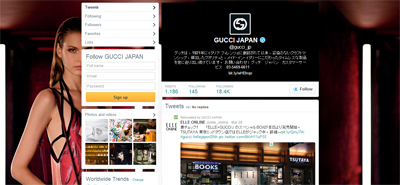Japanese retailers are seeing slow growth in ecommerce, but brands on the popular mobile messaging application Line are growing, according to a new report from L2.
L2’s Luxury Japan Insight report shows that direct-to-consumer purchasing online in Japan is seeing adoption rates of only 73 percent, compared to 90 percent in the United States. International luxury retailers are stepping into Japan’s online shopping market, as local department stores and ecommerce brands are lacking in the country.
“Index brands' direct-to-consumer ecommerce adoption rate increased by only six percentage points over the last three years as Japanese luxury consumers still prefer shopping at bricks-and-mortar stores,” said Yo Douglas, APAC client strategy associate at L2, New York. “Brand sites are key to searching for luxury goods and act as an online-to-offline bridge.
“Luxury brands have been investing in site search and navigation tools since 2014, and 97 percent of Japanese sites provide store locators,” he said. “However, omnichannel buying features are more limited, as only 19 percent of brands offer in-store pickup of online orders. Improving omnichannel capability should give brands a competitive advantage to serve local customers better."
Online retail in Japan
While direct-to-consumer online retail has not fully taken off in Japan the way it has in the U.S., a popular social media platform is showing its potential to help usher brands into the digital age.
Similar to WeChat in China, Line is a Japanese mobile message application that consumers leverage to complete a variety of everyday tasks. The app has quadrupled in luxury brand accounts in three years.
With the number of brands on the app growing so quickly, marketers on Line need to focus on creating sophisticated functionality that is not only unique but also provides a needed service to the customer.

The Line app is a popular app for consumers in Japan. Image courtesy of L2
“Line is the most dominant social media platform in Japan,” L2's Mr. Douglas said. “The Line adoption rate of index brands has quadrupled since 2014.
“This year, three brands under LVMH, as well as Cartier, Valentino and Miu Miu all launched Line accounts,” he said. “Line has become more than a social media platform, with investment in digital payment, CRM tools and AI. [Line] released an Amazon Echo-like personal assistant this summer.
“Brands should monitor Line’s innovation and think about how to leverage the app to reach Japanese luxury shoppers.”
For example, U.S. apparel label Michael Kors appealed to Japanese consumers with the 2016 launch of its official account on Line, which is arguably the most popular communication application in the country.
To celebrate its premiere on the platform, Michael Kors teamed up with Japanese illustrator Yurie Sekiya to create a series of sharable stickers featuring an exclusive character, trend-setting fashionista DJ Michelle the Cat. These branded emojis not only enabled loyalists in Japan to share their affection for the label, but they also spread awareness for Michael Kors' positioning and image (see story).
Luxury brands themselves are lacking in a retail presence online in Japan, allowing third-party platforms to take over in terms of sales dominance.
Marketers and retailers that are doing well in the Japanese market are focusing on localization. Creating special social media accounts specific to the Japan segment is important in connecting with affluent Japanese consumers.
With the ongoing upheaval in the luxury goods market all over the world, Japan is crucial to the success of these brands moving forward. The country is billed as the second largest country for the luxury goods market.

Gucci's Twitter account in Japan. Image credit: Gucci
Japan makes up 11 percent of spend on luxury goods from its consumers.
But tourist spend in Japan has taken a downturn, which means the Japanese citizen is more important to luxury brands in the country than ever.
Luxury department stores in Japan are successful with bricks-and-mortar but are lacking in online retail. Many department stores only sell a small portion of their brands online.
Japanese importance
Japan is a market that is highly influential in the luxury goods market, with more luxury brands making moves into the country.
For instance, British apparel and accessories label Mulberry set its sights on Japan through a new joint venture.
The company signed an agreement with Onward Global Fashion Co. Limited (OGF) to operate its business in Japan, looking to tap into the potential within the market. While Mulberry knows how to position and market its brand, linking with a local player that has extensive experience in Japan is expected to prove beneficial (see more).
British apparel and accessories brand Belstaff furthered its goal to increase its store footprint in Japan by opening a boutique in Tokyo’s most talked-about new retail space.
On April 20, Belstaff opened its first flagship boutique in Tokyo, selecting the cutting-edge Ginza Six development as its location. Belstaff entered the Japanese market just last year with retail spaces in department stores Matsuzakaya Nagoya and Isetan Tokyo as well as a shop in Kobe (see more).
“Traditionally, department stores have been major sellers of luxury goods offline in Japan, but they have struggled to increase their online presence,” L2's Mr. Douglas said. “Luxury ecommerce portals Noren Noren and e.Castel are both owned by leading department stores in Japan, but distribute only 13 percent and 15 percent of the index brands respectively.
“Also, Noren Noren’s fulfillment speed is surprisingly slow with a delivery time of seven to 10 days,” he said. “This situation creates opportunities for global etailers such as Yoox and Farfetch to tap the market with a wider range of products and more competitive prices.”
{"ct":"ie8OIU6RG2579D2AVXDk5OG0Zo3EBCfqLOjpaJiGhkCyTc5u2X1dPcFBCT02xTbHNlpWBFe6k1oaoJVURlE9K2SOhPVwwRkE7w1VPXcF10fsx0MH1ge66pbMNXd9caQGCV49Z8HhFmT+cRZCRLR0rN\/+UBFcLuUKkjn7eEmU5qvOMD2mJd6MvUqn+KS3jf6vg5EBLT\/HVdbMylV0LZohFgnU\/ahoZVG3QdyX6evZjDsZwpn+zwuyrIkRmrAikRow1fW53zB5tD3PS5W+dITiAeo1mIYgRDGAOwzZqTilUWiGfaWTIB\/Kciy7nEay3oeyyKXK83akbLmSfvTmabBQxMxv4UD+OiZy4\/FZHxNQDwvjLHtFZG9ermTW3rAJ4Ia84vAQxRGQmv922xhrTuRJfdQea7rCy+sWMicP\/zE0PUMCVvbLOArP3Qq\/d8sco\/emsKaTOdcKtrszTvvG9cwHnALh\/0Mr0PiIQ5B8ucY3mP1fg9iMVmow4Npid3Oj5vIUerqjeZP6BjT2pIIZXzf1H8ATJGHL5aDBsSeV6ueBC4qy+sh7Dzde571z84ASSNX+o58Z7p9i8nL71h0yAu3Hkenbuj76Vhl6dfeEFPU3fmRixeZCR6bJBelIHpgqFgffTQDW6BoT7Elw88V9Qn4RgT44akT4Q+8jWHv6TylW0tLa0yq08VDKG1vMEUtKFVb9\/m87iTWFF3vTGUmkDE8vzZSmB4bYg2zRpd3TRLdqX3k0PlbywZ\/u5yIWjb\/LeAxoSnPQp\/F1gYXPK4KHEqlNnYhj8epxdRNijUsbP5dhctkAl65fjJ6ZpFsykiuc4nsbgLqHpaqEdgTzSkoq7\/CnbZwV8PbNdtQ0TVOTJgnZF+KRgLrn7Mh7Aig377JaRNezZZl6goJXeGh\/IbIQqE9AcJeT9WJsqiTus1XQTwjDH5zDVMytr9co5hPelhqlKhbKgqafMo05bWllGhWiK+6fYCX86hqtHSILSN2KObg83Gq2RaVV1lVG7D6xBK99qxUiVA8MqVxiVGzzv7t8cBC6kuYSbt7MJ+saN5nfMbqfGkW9NAVnVW\/AsYEfHceOxCeCb62tTAhaZ5djLO7c4MIbOcFby9KPrvjq2VPfEQLfa3+0ARojqD9tMEqJIqM94GC25oHTZLH0L9mlYjw3nyn5V07NZ45cnd6pLSDCYAqTrNvbAwCyjzkyj\/7Qjc2ojH6RwS3YKSrq1kUf8\/ZeEEZVSuazL0c39LhQTKdnFQ5oE+Fqo7RZf\/dR0bh4nlF\/LG5TxjLyXhYTajnCOzBYMd7iIG+XNORzxm9gtNHbKngKQNJ+E5NxFfJ8fdHAlYk4Gw1VSmSucZZ4UClXmGdJsO744Yj+mTzrqstc5iWBLTWNl69Kq0wsESxk6SAx\/HB1P4YmRMHgztfhCA5Dd2NkmTgVzg2fA8Ri3T1DMi9pOBoVd7LK7uMQ8oW9\/JoSuPrJ0+Fo1nBXE2+GZsdMzjZs\/JQTAr3WUGhd+4F0iEkeiTtEnvaB\/w+svOtLSfXGkboZGIq3zK\/tseOM7EABWYO0KLIjkJqdP5uL3yTWk8pZq64ef7KTQTl\/TVSSehrovMWFt8fFQZi1V3sd3ZASPsO8RzqWSI7WUsDeSLHCPi4L0gK+kwpgomQkjsG+2zgZRhDku6DgnikxRH7j2rQ0dAUL8Sgq2HHOVKe3+lWtO63j90BkZ7kWCA1cU5fyU\/+\/xfz91sZuE4dhQfP01pCEyi07H638DLhuzVPOhQxLxm36knFpenp4BmSl5oxwHM3eggWQU6GgXHM8yyjxv5eLWUaWB8ZpvxrJrAw8MjJQw4PLQ+0nKiUSG5g\/7vmI0tzYDa6FO+7Ze2ZzKSzZNTXPKMWHXmPJ6WbXGn3wVqaXzT\/MN\/4QudLVFNdlg\/8ryF3hTuoP9LrLMSwG5+SzpEDTKDTnndhnvZPFi72dvrXUfV685nRmX8COsm7ZC1GDfcR+kw3t+feGXJVUtJAnsMUIj5ISp1C05tgGKAb92DyXORwGXJp3qRBYOtcRULfvv9gr9aBtJ+KGW1Y8x0EHkRUybr8PrtqBs9zMO6cgqSDPQm8n2xV6Kqi5dPpDlRvQF6anQgoAGAHTVHb7w0HmDdvM+ijJ7T38Qoa23JosJvkFh+xbsnRnX1Uy992prBIlYD4ur7hgE7NkzyjvjWccO6vvQXK3GVon962r1TqocLNElu2x7r6+DG3EQeRKrpT0fRGjJmLv1FB+kZ8wOxM+4A7\/PfV+uaFCp9sibWDoM39dKRL5RtEB6rOt\/q7Wri4wMNEp+YzCJl3HxqTBba\/lwCk8q2M3GGbH8vphCq2pjBGAy5XWbFWOvBnlnr20UKuhFNSLMEpC8lMybkTqzmVo0jxWUUjC9+euq01mrIKpllbyOESBX\/CSUPvnxmnvbjkGQr41VWm36vwZXXa3cz5gHIxxfvbaAKRfeDquac276g2aeL8bC6Gj4M7jntI183sWfjLa9pn\/HPqfzTU39ilj7Lts1CQ3nxj1S2dActivx1bj9T24UMnJaJjEn95p8v1J27dVP09d0QklJO21Rkj30cliPQsFirQerAlbV5iBE9jEuZ5+c9jUpWTHAMcz0rR9ds8qFGLWbRo1ym73Xzsymx70WRaT77IO88Hf0xxGG27VJ5+VJ8I3rsVck4w\/k1gYM2Fm7RxQMhfbcPqp\/+JTsd8rcE7J8XHD447mnRCMzw9sze6mKZa5ZYtijQtcUpQhY00rdBwIKVik8roSnD2rnP\/OQEElptolAbmVyH50ITTF2vB4bqEgp4XVpaSYkovzf\/Cfhk8WDE8LaxsqrwqimMDtYV6Eda\/e18pybsLMtyQ+rJVEViHRP\/qFSbJ0NDJYkT+zkE9sn4b5zx+pTOsspQnPVbwqTCbTWilu\/a4E5NIaSlBV0NWqa0A1AjMfeU6WYR+Bripse4CVtfO8Sq\/G\/BoEWoaE0hYh+0baxoYyhGJt8IAdACNXAlvbORJ4mMENytNforwpzZPlkOJhy7dQgWsLF+QvqBzB9tB+iikzOhf5cdNu64EQ8GhQ18Ol5EAoY7XSgM+2NjP3lWRPxgkpKP03sfrrH23Vbingodu\/tEI+jOPsnv9o1pB35X17hjFDshLEy1bZp8zxDA\/DFeK2V1ejQVi7XBveY8Cp+yxziRGC62z+0beIxSnrhLd9x\/F853eBliDaO8hXa2n1jGByAKaCIa76AWzVxKcXJsowJRvlh2Kxu6lfLK0hCcSVjTfQFdBt0JE5uRJBZBAmzwYIOjilRDPW+IyizzTPKCxfgC41xhm8gNqTgrMecgzt+OVhuLvYjykL90LRa2cxrAnNEcpk1\/\/lAC8tjqEiJqg0ru+m1uHLcUjXdcP1TJuDAwCjmINcGG001ps1j1MLcRbZH9jesqZKVMwHV9+HXC7rfmYiIl9cQhvwlE1nnCmLWU+x7ev+\/b1JmMANlTqsQnbOZvPsGjdqFMhOwQ7Fu0dH6JcPCUjTt6RhqY39Idg5xPd0gtApEz\/iM310WPo5oHZTEdLytVyYhtHThe+2tISKyN6itD1I16E8VqQONin7TC5MidOdBaH68Pu\/02lSc9R28R7le5PKgiOTTNi++OIPloTfjaNC2DXy7ZpS+x0ZPPZYatP8JqQXeb9dCzeJqvwh9lb8LfMgrKLJg5\/3wopKFNk8IbXcOJpSaUCLfq9RG8hLpPlFWPZ41VkdsjZ+ngUInlgpGpITAs51zKOjNtzYkW75fdtvOn8rql9JomAd2QgbgChcoCvmNLiQGPWkT5KqwTAmNHvAkh7JumdwnQGP2xcVdc3bFJoeujsYN6kCtW1zJmmHhV691xegPpI2apyiH1Zknsh9D6ZYPloZOlcqaoXwDyemw4Hm\/Zkbh\/sRT6mz5rFP4NGTHL1GBUUBMr60A\/sspZEorZiDJ3cgHGFGL0PaOThEVBEVHLw+FkbawErdo+2lejTeC4Fwit8TfJm\/bwL+T7jjzVZnMSCaORc3Riyg\/pYzz7ENl5LcyVooBAqOdl8LU2220o65+uGXxL1dzRSe94d49rvcBWKhdgarD+n6ehrja6HeFVg8HjCWjKpBzZjB4+sUJyDWOCpokXO+sEIFG68WBbmKcSwvRJGW4YRKJ8h7clLc5H9Lx2TWxEGo9jUCfM74\/vagOUow0dK5HP1cHmG5cDShwvvfPnzhSZ3Gr1YSCKmh+PStbCxrE\/7ZiNmHQUdOcSjlALSFeF1A26uOG50gYxS4XwuoqOPCO7b7Ky0dNaYPIFatNX16dB7Y4Do5\/bbbl1K41mceDGFSZKtRpCjisoKAPFaCQ01LNXvpeS0v0ZjuSG\/sfMheoyvpB+PFL91Pq1fiFAZViaGjz\/nUhoifD0jRaW\/E6Uj8KFAJqiWqQJpV3GSfR4sRsTLqv6EV1zWavwi4f9Iczzd0R+F8PIXFY36Bqug9eNiwnCpD5j55JGCUnw4E4VSyywZrF1a2q9wG8bkLxzOJcLChSdqaaUnEuXxHsir3TKbdvRJLMXfHF95Xcx6UdQeNN5w9dqeUW+PO56\/5WCtNWLIoBqnrjNLhyBYVChWAa+VHPh9SfrmYSYM7fg9Qt+0wdnLII5aFWDWQOEs7O0Mqebn64VuBR8sDlNLQdJML12lARStjY4vc\/5A15dq3oV4f3CLO+hhnMTroad0o1dGYD2iHn0EG03v+BZ+mQMLmgHY2KYwHeXIMmEv3ErG2AgsKIZF+oKSLdNiMiXf9RBd2PteXx1ylPkoiBaQKEEr8Z+f5UET\/wa40rFF6qFtvn2WInr3yDsRj+01ehA\/mfUYfMhZWzkIcNgGjcXJFFVa31d5WRPc1XoQofP5bzvJRHWk5sr7Ptb5WCF6bWOy6wSToQ61mFg6stRomrMk06yqo6+t0f\/wLVWwnBesTnB7bP8gdYjmuCXdRYTQnkMsTx\/gi6MKigtDAqPNQLZ1FEIu5qFrpHiChmUG+wLHA7NEDyA\/6SojFqdqBcalij5SCAR1eauXB5Rb3yYJ69A07dvtGvnhOaSOScqizTbmhe4IxhxpxEPFV6+XJn7YuibLer\/3vRcHI5Jv5oa3FFO+3o3NBurpR6zzGNFe8ivKHU1WGs8qo2HHDw3z+6lMdcuW8s4Lu3RwRESwFKm2n3Qwaz+Qt3knZTmAQTxzJ51Qp5kl4LtLh\/0Newp\/02NJOFhj3G9oKv4n0oZs4nyGihZcEnrbvydxYNteo0EzknFoJx0m0Q75Sah33q5n2QeANir7+iEmog2Ej7Zebm5ibJ\/kUoiV85wPxVQiviA+3Ey7IIOIaw96UzWYKMBaCVXZ8S19rpu2KM\/uZCEyrRgkyT3Nusfm8VPLYaHQfYz7rgB4MZ\/DgS5QQtepN7AifcKTnZYvOU+2QxS6J30FRZ64bL1AW+l\/k2FIyyq6LTv3Ec3DASKUYfsyaQTESX1GySOP2l+qkMgPS0jQD9XgxuKXo+8rqMQJnCh1ug9xcxq9KjR4dL+Wamawg6ylEESJIrFjC9YuN8cIQe3BxtEuI6fxuK3Q6VSlgtIJ2cYutGxK5rdYcGv6REGoaOfm5Bw2jfuCk8bOshQhZ\/QMJQ5k+Y6vZNWaTEqomDscdeN6mOvsDAbHhEt1e793wr5AkObehLic1QbhXbG\/ClLGaY0+fNdttdWziIrbYn9wpQxH+s1KaVaZQm+OuEDd4TUUffS1w\/1ZFosq8\/UHj9dJ9WRn0IvdWahL5hblcM3WrFC2RGmbOCgvpZkpl9mDbXU75myY8\/Afa7vVruQnqvVCtZ3T6BT7WAA45ZI5k9iZ2Fxi\/ZVp8I4TbWeSfl+U05PFASbaoH1MxRjqyQFHtOLG4DPAk6fwZRLyWb4nfHfHuZNSajmkjlWZg\/81ApSOqRnkbC4angPQuqxmnxb0Hg8W2iA7Q79U3pacegFD+xJjB+vHi\/d+xXVnPl49DIZwAylDz0Z4NUyssBpBM69qSmD513QPmULBMnFHYZS9z\/u+bqNKeB653Gw8IOp34wRTSgIhjk0gGVda+ls84IJWxYUmrdc+uyuG5vNr9TSLcCAh1uon5FV6Wx6fZbofSJp0V4ucbkRwXoMF9Ejq8X1814RtEMKNEl03fp7B1a3acEhfoMR5Xj7T7dQ1OUuDp3jME0lNpbEQ5p1v0zlCO7Afdb+ankyhKtWKMY3Sp7b7iwLP8agE9XAint+B9UzZPEE6g52h47QxZbyaL8fQTMYigNP6Lub1Lz9b+dy0UjgiIvTxKF+nlJbPOrDsOR3Dbz0oG3Q6z3luXBgRMus4N5KZiSxSOcltLAg2KthwoFdHKmap23q83FJ7MJ\/sXo58Rk0t7okA\/UPfQ9hISZjYQgWa1XqQhzxqKzI1wxGJshfQw6OhcXLw1Mv4dN\/k+T20E5HLKhOnfyvpFp34s37HFyvaYYwqI81tiqIPQWWfXcJrQDWyK3bdjvl2oULP5kRauhF5g9P\/Q3N2PI9o87GvG2nAfWsOy\/W2xvVGE46nLBFLX+Zr1vFYFgakPKlVh+wvMdhDhvgcaHFpbAwcc5eX2zh1MWznvqpCgOQcFkIt3mnhhgMMWVEaDQHisQiWEj4auBe+H0dvPyLEDaHXxtwi4sdicmV1Tkmy8dAxIoGQnyVV20InPmLjkP6Ec7ci3gxrmzAS6I7N1zpclV5HyGMYCft6CMok2Q111GY80khoFs4OnA8afbBdwbUU0If4Tr1krO2tzrwSKUNy4KirmoEYMwhKCCjOeFI7DNn8FbGEig3lsVtazRQ6Qf3qHPgJQhSgQB+UL+u9WrKmO8H4yMlaK9blWpeSWDs7RXu\/6lQfv1\/tNU8VTO+3Lj2DvK1hZ+Ttn3imopBW2bA7e3wS++34K+QG0CNJji4CnNfUjfPeX0guZMpI8nOltjbsaZPh\/UsHnITqm7z0z\/yX85GkAjdD1P08H0apmPZhqTQNC4KzFqRb3QlptLRc1C+hIb6NGiua5noDsWpIR8cKaYTJAKLePy0e+v8NKTs7XsX0JjozS5JznePCKwJPhHFoWxN9XSGonnYzZJKtu7F1BLLzrXlEdJQZ3m3joD09Dy2J22qdXA+y8Yc+5wxpqZQCSP1tMzshpV0oQKwvqyz8SxcXbgwVQ0x\/2UB7yX2n0XU4EbS8Nmcf7RBxtsjkeSHd3A8kB8XR1WAEMULD1jOrHDpYEWobyPaMfMJtI0rPkWweRAHwWEmwk+q2KsizLrQ1U0eAmlYItr\/GqgIDaJVNtVLl6l3vGb2dvWpdHG7se0uPJ3TAfrk2+il7oXFMCDcJK6XSU\/UxeaZvRZz2uXRWkXnad+sgQ9ES5AvBj+xwzzJZDCGk1Qvhu55q5riIlqz\/gWXfBC1b+XwshIRD10p5v1KUKuBPrl0gRv0Y7cn58T5wLtx0EbF4Iwq+eDuN6hRG7SA+Ke2e7jCDgJEWtsyY9bipNy3KwqCnO5n7+bpQeTE3L3VXFF1lWjya3Pt2veCJ3dQ8\/R6KfoQ7iyuJfmxqj4yVePfdCFsuTRJncDQbi6P88N5EO0xMg3eqFbbQskIIT4r7GnmK2TeXcrqa8zFi+nvs0sTgqueyNTOLT\/N\/pgljfqlL8J3PGoom1vtQFe9gSnE0Tidqs+hpSsNc3awc753WQ4ck3EpOO2I1B2ZH7F91GVpgLu2lIDvurGZx9Ecz4LewhhZhmHK3oYwZU2MoCoNrs+udInGH0MPejW5ub5LQHVwQKlWBKreRh8YGFZk\/sh7IY9TKdFiCEP70Jv0J6Rekc3WwMR6DjlMPuEp3JkJOcN0Z\/XWxKtTn0hR370RSyjC8sP2KqbYbiDyEExdK\/UgePUnunMUKnSmQZoBpbkwkrkL\/Imh+1Q4WnlxEhz8Wlum6vPqTBuzdF3bg8dq6cQCoDntgPfxvIU4jHOmmDgJ6GVLcvB2ZeVN40bfoeBXDj9sAyaWYALd7+MOYta5RgF8oaVvn7SlSkq+31zDidgA7jHGuIFu8Na+N4XacUpKSp0UakrQwd\/UqlFtMU\/GWtvitXbAJSUGZ6+l3kmURkJia4YrveZkew0Ij92inx\/Xm5eK+t3ro\/Jl4l1HD9s9orAYHfrYGf7R6mQKa37KHAZxFrFiWAg9dhtSuEH4ztkupHCVE++gfcbDJ3N6Qibj+5H+OP6pDs4PdQJZevT7j6tfmbh0t\/pAk+fbP0LqL+SAM7QsWB+NpqLwQzlRyCWJ7TosZUavSkhAjjdGE+kXCojOffkNo2bmEcmZQRP0sSjA5d3urV\/G4vrHQCWFTi77RM2QMzsL9PN9+qc0fRfWTHMzNRZ8hsS0r9pwzYfAts5jlpJOwx0XuYVYsRBm0qHk3z\/0553EestGVnXjV75IXyZAmWw\/aLDxAkslO6d2axFPcwToxPSqSnxnI3iBZoWGZIRQlj+EhB1EEDCcM7ayjSg7vN0ZQ+7\/tMLjOQFuodyEAVwJ0xw6qAVh3+j\/VU24ThCS6YQ4m+m57X0lu\/hUFvXpfdU+kXK3iVMSFNj8vt5m3YRFYv0D07Ym+6X2Q7\/3htg+zrEQKrKVP+nKf4R8jwxcUf87\/DSFRxnzrZxULmXOc9wjGUxMmWJ3kIM8+E7mDwKtQwxXiNk26TQjIWBsgVOoiJSe4sCtaoSBQr29u0sg1W845xBrwLWDyfFRJ3jJ8hOSe02kBExVLioBteJZkeAbYclRPIye785rs4Ha+Jw8ZhdfQLV2QEEkN3OU135UCK6xpUewC6tlS\/ethc8Ifauoj720yvCG1OErPvZ0R2TVugqG4L0cdu3Dz4GPdLSytu+J5xBw540J9UalPs15z14hp8RZduVCuVsAujTU0IUagRYfvJrlsAPma\/LgTc\/+CnUlXzD4Bo8Xk0\/GyU45FS+QLirlNiGXUrlXgfV0WwDSskiRa5S1DjEPBDD5mfCjZygPaBikL+WdQHJeGKmijiGdKmhvV11L\/qRznOUE5X\/QeubVj4O9Uat16HYK3WD1sqdltvnpFzSUdOi7ydzSSCv2yOcQVmz59jrsEvd4Y+7VUKHipL8MEtgfLYsqIeMQdEE9X\/NmIcB+i3dbv7US6jvhPjbyhZSdj6LCynf2\/ZFcGDwVVpGrI5U1NfBzD1FpLF54M\/4XvITooujXqb7wXtHUu0EYZ4Cs9CYtQlKgqfUy55oWf6iAwHyZL7t4QfKyebk5T6imeiU512Qi6qAjl8MhJDsOjoqtBN+dY+0lK97F6d3lv4aLI2ySr4n3TR331lAXkG9w4CyZc1L7Rsb5PgA55w67YgstOKzDsngrbhuFN+MaMnqL6pODyMp8jFo2CLmdnp+128+TcLEe+t5TQqfoQLsyX+zyErFFUAHXUZ7zSlOvXTrRvYyvN32kBALhhdQwckq7Mpo8jkvBoxY0IM8CksnpSVwbHOOZkymuoQY\/fxjup8MUeMFlhRFBBABurAzvQ\/npjfUpo\/tYK2VxVgu0zIzHf4kLGmWwHVkOmI1txe1v2CY4MKMvoK940aOoabzYwWfV+vkPtz9JA6RC4trImpUyHXvFPqlueWEW2z2yGu248ATIABk1SOck8MjHYXgLJc7bONtkvn4P07kW\/ReIPkYiFCXbT5NJ2yxgHVg4Fkmnokiu+QOWv6YfGW1ng2VK2QLsOY6CmHf+Nytk5VbXa+x4sc+VTEBkEqL9giq4nFvcnGxs8A07N6joxGjDhWc+WOUL++BLkjpOgic7jExWqrZsccq0p63ZSAX7oYdTGGoUJtP2c0QAiRa8jT4sGMLPUchRlat\/Mhi5dunusoHi55HhEVdjnRGEN98j9DWFEroOyNPMgjKuVUA3o2+eWkQSX40EnihvRyomoTF5KnJr1JV4MqlS1f9JM7znhFWkl57oi\/73O44rwAjHo0E1hWb+fhvQNJIlmthfX2J5RTkiuG\/qFzYAkg27do7NOUY37c1Kz1T4Az10Frs9RX5vOESKeCRFHE6h0qyK4YhNY2Fc3lNPB628J0QAPihFvcnXxWHkAy4YIJhRh8RRRWyV5cbF2HtzTciQnk7vZGbqNtnBnGOuVD987bRyHIXQ7qdEkeaMEsIoySuBxL\/zEoHbeGlAU0YSQZPxUj0D5B6cZzZucNtzx35zhihot\/8tiir+tUzH0C3I5+corXvgeEx7y4nmghWVRod1oWYoDjXSGTwHv\/UcxFzg==","iv":"edf636d3c0773bc5c5702c4a05636b04","s":"eb1741c5ccb1cb82"}

 The Line app in Japan is a major tool for brands to connect to consumers
The Line app in Japan is a major tool for brands to connect to consumers